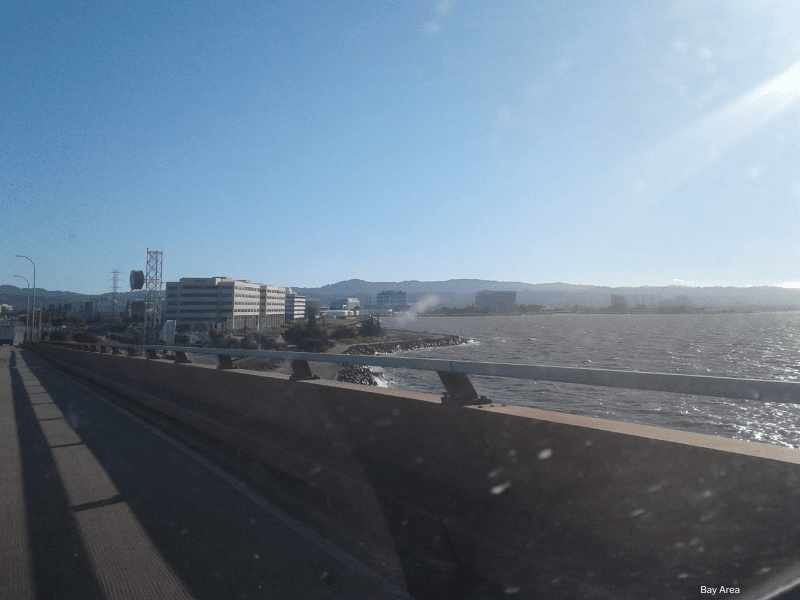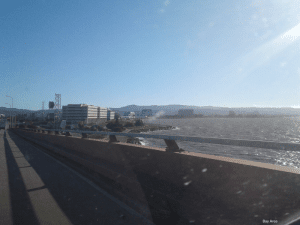If you have ever driven along San Pablo Bay on your way to or from the Bay Area, chances are you have driven along State Route 37, which became a battleground between climate advocates and road lobbyists this summer.

State Route 37 is a stretch of a two-lane freeway running on top of a tidal marsh, prone to high traffic and frequent flooding events. To try to combat the first issue, Caltrans applied for a $73 million grant to build an additional tolled lane along SR 37. Their fact sheet touted the ways this project would reduce air pollution and GHG emissions, improve safety, and reduce congestion. The problem? They ignored modern science and the impacts of climate change.
Caltrans’s application argued that this project would reduce traffic by building a new High Occupancy Vehicle (HOV) lane, widening shoulders to create a safe passage for bicyclists, and funding a new microtransit program. However, they failed to consider how much vehicle miles traveled (VMT) will be generated by the new tolled lane. In a process known as induced demand, traffic actually increases with each new lane added, as more people want to drive on what looks to be an empty stretch of road. While tolled lanes are supposed to reduce such traffic by charging drivers and thus discouraging driving, recent research found that tolled lanes only have that effect if they are converted from existing lanes. Instead, newly built tolled lanes can not only have the same impact as a general lane in increasing air and climate pollution, but could even be worse for the environment if they are priced to reduce congestion, as more cars would travel through the corridor.
Additionally, since the proposed project is to be built over a marsh, there is a risk that the impending sea level rise may further flood this stretch of road, leading to closures. In fact, Caltrans already knows this, as not only does its own analysis state that the SR 37 will become flooded by 2040, but this information was also suddenly deleted from the internet right before the approval vote. CCA and advocates raised this issue at the California Transportation Commission’s (CTC) project approval vote but the CTC ultimately ignored these concerns and proceeded, as the Sacramento Bee aptly states, to “dump half a billion dollars into the ocean.”
While the SR 37 project was ultimately approved for funding, with the Governor also recently signing AB 697 to expedite its construction, its tale does not end there. Parallel to the project approval process, Caltrans was also testing its Caltrans System Investment Strategy (CSIS). The CSIS served as a scoring rubric to grade how well projects would advance California’s climate goals and was intended to help decision-makers decide which projects to fund. However, this information was not available before the vote, and even with CCA and advocates submitting Public Record Act requests to view the scores early, Caltrans ultimately released them just weeks after the vote, rendering them meaningless. Surprisingly, the belated document ranked the SR 37 project among the top 3 climate-friendly projects. Feeling suspicious, we decided to investigate.
A few things immediately stood out. The SR 37 project received the highest score out of all the projects on the vehicle miles travelled criterion, meaning that it was found to significantly reduce congestion, contrary to what is known about induced demand. This determination was most likely made based on the assumption that tolls can be increased as high as needed to make sure this project passed its environmental review. While high tolling prices would indeed turn off most drivers from using the new lane, thus reducing this project’s environmental impact, there is no way that would represent reality once the project has been constructed.
The SR 37 project also received the highest score possible on reducing truck traffic impacts to disadvantaged communities. Yet, this project would add a traffic-inducing lane near the city of Vallejo, a community marked in the top 85 percentile of CalEnviroScreen‘s scoring of disadvantaged communities and impacted by high asthma rates, low birth weight, and high levels of groundwater pollution and hazardous waste. This score is rendered further inaccurate since the SR 37 application to the CTC explicitly states that the project would not change the number of trucks going through the corridor.
The discrepancies between the scores the SR 37 project received and the information developers submitted to the CTC do not stop there. The SR 37 project received an almost perfect score for reducing safety, yet its application lists that annual fatalities on the corridor would only go down by 0.01. The project received a few small points for building zero-emission infrastructure despite the project having no plans to do so. It also received high scores for improving climate resilience, despite the project actively contributing to climate change and sea level rise. Finally, Caltrans was also asked to calculate scores the CTC would give the project applying to its program, and the scores Caltrans calculated for SR 37 and other projects differed wildly from the scores they actually received.
The Caltrans System Investment Strategy was originally proposed to help further align transportation projects with the work California is doing to achieve its climate targets. However, like many other similar laws and regulations, its actual implementation leaves a lot to be desired. Despite advocates’ efforts, Caltrans released the CSIS scores so late in the process that it rendered its own work pointless. And when those scores were examined under a close lens, they fell apart quickly due to lack of consistency with the CTC project applications. The SR 37 project was not the only project to receive this treatment, as other highway widening projects also received conflicting scores that claimed the projects were both reducing VMT and increasing traffic near disadvantaged communities.
This just begs the question, what is the point of CSIS? As it currently stands, Caltrans is both wasting taxpayer dollars and its own employees’ time coming up with numbers that don’t make sense and aren’t being used. All of this just seems like a smokescreen to make it look like the state is changing its behavior and promoting more sustainable projects, when in actuality lane miles, GHG emissions, and air pollution all continue to grow. With Caltrans currently in process of updating its CSIS methodology, CCA will continue to push for more transparency, a faster process, and the use of more accurate data to ensure that CSIS actually accomplishes what it sets out to do, which is to create the sound analytical framework for a more sustainable transportation system for all of us.








